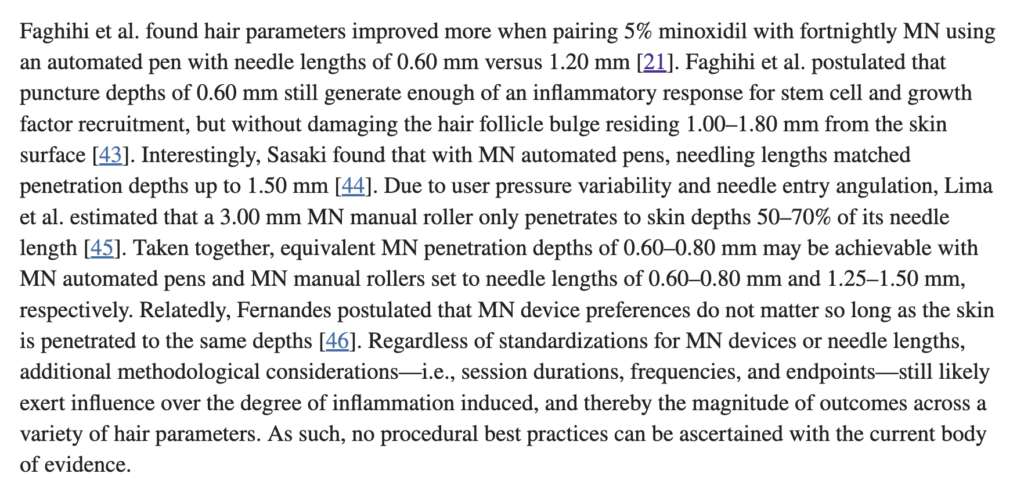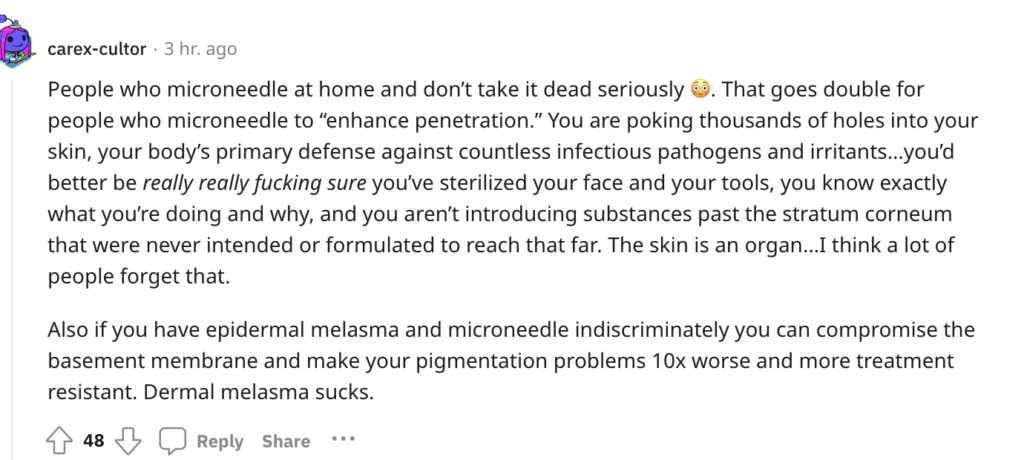Microneedling is an interesting technique when it comes to potentially stimulating growth and is often praised as a natural technique when fighting hair loss. This post aims to be a general guide on microneedling for beginners.
Note: To be fully transparent – I have changed my views on microneedling itself and is now something I avoid doing. The risks don’t seem to be worth the rewards (if any) in my opinion. This is coming from someone who purchased a higher-end microneedling device.
- Disclaimer: This post may contain affiliate links so we may receive compensation if you sign up for or purchase products linked below from Amazon or other affiliated companies. Full Affiliate Disclosure. This post does not contain medical advice, we, Hardmaxing.com, are not medical doctors, this information is for general and educational purposes only. Full Medical Disclaimer.
Why Microneedling?
Microneedling is an option for people experiencing androgenic alopecia as it’s a proposed way to stimulate growth.
Mechanism

Image Source: Promocell
Microneedling the scalp itself targets the Dermal Papilla which is a control center for hair growth. It supplies blood and other key nutrients to hair follicles which is of course critical for the maintenance of hair health and continual growth. Study
Research has been done that showed the Wnt proteins (these manage cell growth and function) and wound growth factors caused by acute microneedling damage stimulate dermal papilla-associated stem cells therefore increasing growth in the hair follicles.
Benefits
As we just found out through the mechanism of microneedling, we know it drives an increase in growth factors, blood, oxygen, and nutrients directly at the base of the hair follicle. It does much more than just that though: it also increases collagen in the scalp as well as helps with other factors implicated in hair loss aside from DHT.
As you may know, DHT is the primary cause of androgenic alopecia as we understand it today. There are other factors involved in hair loss though such as inflammation, Wnt proteins (like we learned about earlier), other growth factors, and stem cell activation. These are factors involved in hair loss that your well-known compounds like finasteride and minoxidil aren’t acting on.
This is why microneedling is so valuable – it acts on an entirely definitely area of hair health allowing for a synergistic restoration of the hair follicle.
Another reason is that just like the other factors that are being helped at the level of a hair follicle – collagen production is also being enhanced. Numerous studies have shown significant increases in collagen amounts of various types in many different contexts such as skin, scar healing, etc. The benefit of this in the scalp would be similar to benefits seen in the skin: thicker scalp, healthier structures in terms of the scalp skin itself, etc.
It logically follows that if the scalp skin and surrounding area have more collagen the area would be more favorable for something like hair growth. If you didn’t already know – collagen starts to decrease around your mid to late 20s but this of course varies and is likely associated with hair loss as well. Older men continually lose hair while having lower levels of DHT compared to levels in younger men. This is because the age itself eventually does the damage rather than DHT alone.
Finally, microneedling creates tiny holes in the scalp (temporarily) creating more opportunity for the penetration and absorption of hair loss topicals. This is especially useful if you use something like topical minoxidil, topical finasteride, or other hair loss products designed to be used topically. I’ll talk about this more in the usage section but it can increase absorption so much that it’s not recommended to use minoxidil the day of microneedling as you may get too much minoxidil systemically and experience side effects. I’m still uncertain if this is an actual benefit or not because there are other ways to enhance topical absorption and with something like finasteride you may not even want it systemically.
Dermapen vs Dermaroller

Here’s an image from this study, as you can see microneedling pens seem to be a much better option. The only negative the study gives is the fact that these devices are only accessible in professional environments.
Fortunately for us and unfortunately for clinics trying to upsell this service to sell for hundreds of dollars – these products can be purchased online for a reasonable price.
I use the “Derminator 2” microneedling device and I will probably write an entire post about it one day. It is sold by a European inventor focusing on medical-grade products like these. You can check out her store here: derminator.com and owndoc.shop for more information.
The device itself costs $200 and the needle packs for 12 needles (the option I chose) cost $4 per pack. I bought a good amount of packs in bulk, seeing as I don’t want to rely on them in case they stop selling the needle packs and I also don’t like paying for the shipping every time.
Some people also use a device called “Dr. Pen” although I wasn’t sure who the official retailer was. I’m assuming the results will be pretty similar to a Derminator-style device, the pen just seems more flexible for both use and travel. From a quick search, it seems like this company manufactures them: www.gzekai.com, and everyone else is just a reseller. I could be wrong but just research the seller you choose before buying if you choose to use this product. Many users online heavily enjoy this product as well – it seems like it could be a quality option for a lower price compared to the Derminator.
Now that you know microneedling (Dermapen) devices are available to the average consumer we can get into a more direct comparison.
Direct Comparison
Dermarollers tear the skin more because they aren’t inserted uniformly unlike how microneedling devices work. This also means they aren’t as strong and can’t reach as deep. They don’t have customizable settings. Most of these rollers also don’t allow you to swap out needle cartridges which is extremely unsanitary at best and dangerous at worst.
Overall these devices are cheap for a reason but you shouldn’t be lured in by them – at the very least check out an automated device.
Microneedling devices or Dermapens on the other hand are the exact opposite. For the Derminator brand at least I can attest to it having tons of customizable options: speed, depth, etc. You can also choose how many needles you want to use in the first place when buying needle packages. I’m assuming the process is similar for a Dr. Pen-type device. Because needle cartridges are used, you can swap them out after each use meaning you won’t
This means I can use the product at very low depths for my face if I want and then go back to something deeper for my scalp area.
Usage
General recommendations are to follow strict hygiene protocols – you don’t want an infection while doing this sort of thing. All of my needles come in separate seals and I take them out specifically for each session to put into my Derminator. It may cost a bit more but I don’t recommend reusing needles to save money at the potential expense of health.
To be clean you should be doing this after a shower so that there is less of a chance for anything majorly harmful to be on your scalp. Most people keep their scalp slightly wet so that they can easily glide the microneedling device across the scalp without it getting “caught”.
Fair warning: most people online say if you experience pain from this you are just overreacting – for me even .75 mm definitely hurts but it’s only something I do once or twice a month so it’s easily doable. I don’t say this to discourage you but just know it’s not a painless experience given what I expected from the commentary online. You won’t need a numbing cream at all though. The most annoying part in my opinion is the thumping on my head rather than any acute pain.
Maybe the experience is more unsettling and weird rather than painful. Think of it like an imaginary tiny snake biting your head 1000 times – you’ll just have to see for yourself (the Derminator is quite a beast).
Depth
Most of the studies on this topic for hair loss are generally using around a 1.5 mm depth and the consensus in online hair loss communities seems to be around 1 – 1.5 mm. Anything more than this is overkill in my opinion and you may reach the point of actually damaging your skin over the long term. However, there have been studies that showed better efficacy at .60 – .80 mm depths and this is interesting for a few reasons – check out the image below.
Someone brought to my attention the fact that microneedling machines are consistent in their depth while manual dermarolling devices only get around 50-70% of the depth of the roller itself. This may be leading to a lot of misinformation in terms of what an optimal depth is depending on what device/technique people are using.
A lot of the studies use a depth of 1.5 mm with dermarollers which may be where the misconception came from.

This review study goes over a good amount of microneedling for hair growth studies and is the main reason I now choose to stick with .75 mm.
I also wrote a post on microneedling depth and different devices here.
Timing
In terms of timing the consensus is 10 – 20 minutes per session around once or twice a month. Some people perform these daily or even weekly which is pretty crazy to me – the whole point of this is to induce acute damage to the skin to enhance growth factors so you need to give the skin adequate time to heal itself and regenerate to receive those benefits.
I’m personally fairly cautious when it comes to hair loss treatments – the last thing I want to do is go overboard with this stuff and create more of an issue like scarring or non-acute damage to the hair follicle that may worsen loss instead of helping it. Although like most things in this area, it is personal and you may find that doing something more or less provides a greater benefit.
Cautions

Besides being hygienic you should be aware of a few other things relating to microneedling safety.
- Sun Exposure: For a few days after microneedling you should avoid sunlight exposure. This is because the procedure will increase your UV sensitivity. I suggest a hat or staying indoors.
- Hygiene: Just to reiterate this point, always use fresh needles and only microneedle on a clean scalp. Never share microneedling devices. This helps prevent infection.
These are the main two things to be concerned about in terms of safety. If you notice any irritation, discontinue the procedure.
Studies
If you want to dive further into this topic you can read through some of the studies I browsed while writing this post:
- A Randomized Evaluator Blinded Study of Effect of Microneedling in Androgenetic Alopecia: A Pilot Study
- Microneedling and Its Use in Hair Loss Disorders: A Systematic Review
- Review of applications of microneedling in dermatology
- Microneedling for Hair Loss
- Microneedling: Collagen Induction Therapy
Final Thoughts
Overall I am not entirely sure about microneedling in terms of hair regrowth. These studies seem to support it but as others in the hair loss community have noted – they are not of the highest quality especially when compared to something like finasteride.
I am especially concerned with potential scarring as that is something that has been shown to happen in recent studies – I’ll write about this soon.